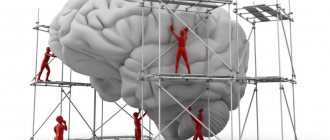Updated July 24, 2022 564 Author: Dmitry Petrov
Hello, dear readers of the KtoNaNovenkogo.ru blog. Our vocabulary contains a lot of borrowed words, the meaning of which is not always clear from the context. We have already discussed such terms earlier (for example, pragmatism, correlation, deviation).
Today we have a very interesting topic - stereotypes and stereotypical thinking. If you think that this certainly does not concern you, then most likely you are mistaken, because we acquire stereotyped thinking in childhood and without it it would be difficult for us to perceive reality.
So what are stereotypes? Is this good and bad? Why do they form in us and how can we get rid of them so that they do not interfere with our lives? All this will be discussed in this article. It will be interesting, I promise!
Stereotype - what does it mean in simple words
A stereotype is an established image of a person, phenomenon or event. This concept was introduced by the American journalist Walter Lippman in the twenties of the last century.
He borrowed the word itself from printers . People in this profession use the word stereotype to refer to a printed form that allows text to be reproduced several times.
Walter Lippman identified several properties of stereotypes:
- they make life easier;
- they are often incorrect;
- they are not produced by the person himself, but are acquired from the outside;
- extremely stable.
The word “stereotype” itself is translated from Greek as “hard imprint” . This is a kind of thinking stamp that helps to form certain images of events, and can also prevent you from looking at the world more broadly.
The dangers of stereotypical thinking
Stereotyping is considered "laziness of the brain . Why think for yourself if others have already thought for you for a long time. Why waste your energy on an objective analysis of people's behavior if society has decided that one is good and the other is bad.
In the 21st century, when not only technology but also people’s thinking is developing, stereotypes create more and more problems with the perception of the world and narrow their horizons.
The more stereotypes a person has, the less educated he is and the more susceptible to manipulation by others. Such people are called “wingmen.”
Nowadays, everyone should have their own opinion on any situation, everyone should be able to think independently and objectively assess what is happening. The correct expression of one's thoughts and their argumentation is an integral part of a developing personality. But we need , you will learn about this in the next paragraph.
Why are stereotypes bad?
Let's summarize and find out why stereotypes are dangerous for society. We have already said that people do not know reality. Many stereotypes are false.
So, if children are raised by a stepmother, it means that she initially treats them poorly. A stranger's woman, according to people, cannot replace her own mother. This stereotype is old, drawn from folk tales. Reality has long confirmed the opposite. All people are different, and so are stepmothers.
Stereotypes create an illusion of the world, a picture that is unclear and untrue. They do not allow the individual characteristics that each person has to be revealed.
It is important not to judge a person or situation in advance, but to carefully study the details and only then form your own opinion. But stereotypes are stronger than us, no matter how hard we try, they fill our consciousness and have a powerful, destructive effect.
Why are stereotypes needed and how are they used?
Stereotypical thinking is common to everyone. It was not given to us easily. Stereotypes help save mental effort and time to help us make quick decisions in repetitive situations.
For example, historically the division into enemies and friends was necessary. Stereotypes helped to automatically perceive strangers as a source of threat. Often in our time such a function is necessary.
Think about what you do after you wake up. Surely you have a certain set of actions that you perform on autopilot. At this time, the brain adapts to the daily work schedule - this is much more important than thinking about every step.
Or, for example, when you enter a room, you see a table and a chair. You don't have to think about why they are needed, you already know how to use these things.
Did you know that Albert Einstein had 5 identical sets of clothes in his wardrobe for every day. The great physicist put together such a set so as not to waste time in the morning choosing a suit.
The saved time and effort can be redirected to more important tasks. Nowadays, Mark Zuckerberg resorts to such tricks.
Stereotypes help free up mental resources for thinking about other thoughts; they perform a primitive sorting of information. Stereotypes also help to understand how to dress and act depending on the situation and place.
Stereotyping in psychology
Stereotyping refers to classification, evaluation and perception, the basis for which is the common judgments of a social group. Such assessments are based on stable stereotypes and information about similar characteristics. Example: “All Spaniards are crazy about tango.” It is one of the main characteristics of interpersonal and intergroup perception, as well as a reflection of the affective and schematized coloration generally characteristic of this form of perception.
In psychology, this term refers to the process of attributing similar characteristics to members of a certain group, without sufficient understanding of the differences between them. Based on simple general psychological mechanisms, stereotyping has become a complex socio-psychological phenomenon responsible for many functions: justifying potential negative attitudes towards other groups, maintaining personal identification, and others.
What are the stereotypes: examples
Below are some examples of modern stereotypes. If the list seems incomplete to you, you can supplement it by writing your own examples in the comments. Let's start with gender stereotypes.
A woman's place is in the kitchen
Unfortunately, even now, in a developed and equal society, you can often hear similar phrases from men. Some believe that a woman is a stupid and helpless creature, whose purpose is to cook borscht, wash, clean and remain silent in the company of men.
This is a historically Eastern model of thinking, but Slavic men often adhere to it, just not so clearly and categorically.
A girl in business is not taken seriously. If a man comes to a business meeting, then he is a priori taken more seriously than a representative of the fair sex. Everyone forgets that in any business, ambition, responsibility and a sense of duty are important , not gender differences.
A man must!
From childhood, mothers try to raise real (in their understanding) men, they strive to beat any sign of weakness out of the boy, because “a man must be strong!”
This is correct in nature, but sometimes when there are too many such stereotypes, it can lead to low self-esteem due to non-conformity to the imagined norms. And then it will lead to many problems in building relationships with the opposite sex.
How often can you hear a phrase on the street from the mother of a little boy: “Stop crying, men don’t cry!” From childhood, boys are taught to keep all their emotions to themselves, which can lead to serious problems in the future (you can read more about this in the article on psychosomatics). Tears are a natural process, so everyone cries, regardless of gender and age.
Men, like women, have tear glands and ducts that help cleanse the eyes with moisture. Under the influence of certain factors, tears are released. The difference is that boys are raised a little tougher than girls. From childhood they try to put it into their heads that they must hide their feelings and emotions, that they have no right to weakness, and so on and so forth.
Why do men die earlier from ulcers, strokes, and heart attacks? Because women are allowed to cry and have the opportunity to release negative emotions, but in this case it is more difficult for a man because of social clichés.
Negative emotions do not disappear from the body. They accumulate like a snowball, and one day they will make themselves felt. Therefore, it is imperative to look for ways to release negativity. Sublimation helps fight negative emotions and internal tension.
Men shouldn't feel pain
Exhausting mental or physical pain should be tolerated easily by men. Any injury is nonsense, a blow below the belt from your best friend - throw it out of your head and forget, parting with your girlfriend, divorce - an opportunity to become free and have fun for your own pleasure.
In reality: sensitivity to experiences and physical pain is purely individual.
All people have their own pain threshold, which completely depends on the genetic factor. The level of stress resistance and physical development also matters.
The male body is designed in such a way that it somewhat easier due to the high testosterone content. But this does not mean that a woman cannot be in better physical shape than the opposite sex. And it is at least unreasonable to evaluate everyone from the same position.
As for the state of the soul, there are especially no clear criteria . Everyone deals with the problem differently.
A man must be the breadwinner in the family
This kind of statement is very common. For some reason, it is believed that it is the representatives of the strong half of humanity, since the time of the mammoth hunt, who must fully provide for their entire family, coming home sometimes. The rest of the time the man works hard at work, earning a living. At this time, the woman takes care of the kitchen, comfort, sits at home, bearing and giving birth to children.
What if the couple decided to do the exact opposite? The woman builds a successful career, while the man takes care of the house and children. By definition, he is already a gigolo. But is it?
Reality: Masculinity is not determined by salary level.
Firstly, as we all understand and this has been proven in practice, looking after the house and children is not so easy, and sometimes much more difficult than working. Based on this, we conclude that all decisions in a couple must be made jointly and satisfy both parties, regardless of the distribution of roles .
If a wife’s comfort zone is work, her own business, climbing the career ladder, and a man wants to take care of the house and knows how to do it masterfully, and for them this is the only acceptable solution, then why not. In this case, the result and the internal atmosphere are important, not stereotyping and generally accepted opinion.
5. Good children obey their parents
Another stereotype from parent-child relationships that can lead to disastrous consequences for the child’s psyche. When parents often tell a child that he is bad because he does not obey, the child’s psyche perceives these words as: “I love you only when you are good.”
More on the topic: 5 mistakes parents make when choosing a profession for a child
For a child’s adequate self-esteem, it is very important to feel the security and unconditional love of his parents. Regardless of behavior. If children are playing around, they should not be deprived of love and there is no point in saying that children were different before, that young people have blossomed and there will be no one to bring a glass of water in their old age.
Right wrong
It is considered right to receive a prestigious education at a well-known university. The most prestigious professions are lawyers or economists. The wrong professions are artists, actors, singers.
We are taught from childhood not to listen to ourselves, not to follow our dreams, but to live “correctly.” But everyone forgets that this “correct” is different for everyone.
The main thing in life is to do what brings happiness . If a person likes his work, then he will definitely achieve success in his field. Unfortunately, many people go to work just to earn money, without thinking about their emotional state. That is why so often, even among the richest people, crises, depression and a feeling of constant dissatisfaction with life occur.
If you haven’t yet decided what you want from life, then be sure to read about how to find a job you like.
7. Prejudice in professions
Depending on personal experience of communicating with one or another representative of the profession, people develop certain stereotypes. For example: “police officers are brave, brave, strong” or “doctors can do anything”, or “you’re a psychologist, read my thoughts.”
These are all stereotypes about professions that have nothing to do with real work. It all depends on a particular person and the situation in which he finds himself, and not on general ideas about professional activity.
You can learn about 5 more gender stereotypes in the video below.
Types of stereotypes
Let's find out what stereotypes are. This is not an entirely simple question, since there is no single classification. Stereotypes are viewed from several perspectives. For example, O. Komarova identifies three types:
- ethnic;
- professional;
- half-role.
And V. Panferov divided all stereotypes into expressive-emotional, public or social and anthropological. We will look at the types of stereotypes that we most often encounter in real life.
Age stereotypes
An age stereotype is formed by one generation and passed on to another “by inheritance.” In addition, each age group is characterized by one or another social attitude. In turn, age stereotypes can be both positive and negative, carrying a negative message.
For example, if we talk about an elderly person, we automatically imagine a decrepit, feeble old man. We don’t think about the fact that he may have excellent health and an adequate perception of the world. We attribute all his mistakes or merits to his age.
Gender stereotypes
Gender stereotypes are public opinion about the behavioral forms of a man or woman. We are sure: a woman is incapable of driving a car well, and a man is incapable of baking a pie. Practice shows the opposite. But this is not proof for us.
Gender stereotypes are also developed over time. Their appearance is associated with certain values in society and the experience of previous generations.
It is very difficult to overcome gender stereotypes. For example, almost everywhere the role of head of the family is given to a man. Although in reality it is often the woman who supports the family.
Or, for example, it is generally accepted that maternity leave is the responsibility of the mother. But the father is also given this right. However, in this case, society forgets about equality and condemns couples who switched roles without agreeing with him on their decision.
Heterostereotypes
Heterostereotypes are an assessment of another nationality. This type is similar to ethnic stereotypes, but there is still a difference.
We create for ourselves a general idea of each people. And according to this attitude we judge an individual representative of the nation. Our assessment includes a person’s appearance, his character, customs, and temperament. We deprive the individuality of a particular person of a particular nationality.
Social stereotypes
Stereotypes of public opinion play a huge role in our lives. They are formed in a certain society, in a particular area. They often have isolated distribution and have no meaning for those who do not belong to a particular society.
Society can be characterized by different characteristics. For example, teachers have their own professional stereotypes, while residents of the city of Voronezh, for example, have different ones.
Social stereotypes
A social stereotype is a general attitude; it applies to all social strata and does not depend on the position and status or profession and gender of the individual.
It is generally accepted that children of wealthy parents are weak-willed, spoiled creatures who get everything for nothing. The heir to a rich mom and dad is initially deprived by society of any positive qualities. If he graduated from a university with honors, it means the document was bought; if he opened his own restaurant, it means his father gave him money. No one is interested in the details. We know the results in advance. We don't need confirmation.
Ethnic stereotypes
Ethnic stereotypes are also a general idea of the people living in the same territory. For society, historical facts, information about the culture or way of life of the nation serve as reference points. With all this, knowledge is superficial.
We endow all representatives of the nation with common characteristics. For example, Tatar women are proud of their ability to bake delicious belyashi or echpochmak. When a Tatar girl is asked to bake a pie, everyone is sure that she knows how to do it. But expectations are not always confirmed.
The most popular stereotypes about Russia: examples
Usually, when people are going abroad, they keep in their heads a list of so-called stereotypes about a particular nationality. Over the years, Russia has accumulated quite a few stereotypes that foreigners continue to attribute to it. Some of them are partly true, others are completely untrue, and this can be said about any state and its people.
It is very important to understand that not all people are cut into the same mold. Therefore, the time has come to dispel some age-old myths about the Russian people.
Most popular name
Ivan is the most popular male name in Russia . It's not even Russian. Rather, it is an East Slavic version of the Hebrew name. From 2010 to 2016, the name Ivan occupied sixth position in the list of the most common male names. The top three were occupied by the names Alexander, Sergey and Dmitry.
By the way, even Russians often call the name Natasha the most popular female name. Nevertheless, Natasha takes third place, Elena is in first, and Olga is in second.
Appeal
Russians call each other “comrades” . This word was invented by the Bolsheviks to replace the pre-revolutionary ways of addressing people - “Mr.” and “Madam.” You can address a person “in a comradely way,” but this has long gone out of common parlance.
And if you suddenly hear such an appeal, then, most likely, it was said with a slight touch of irony.
How Russians dress
All Russians wear a hat with earflaps. And also a military waist belt with a buckle. And felt boots with bast shoes. And, of course, a traditional Russian shirt! Russians do not have traditional clothing. Russia consists of many nationalities and cultures, which implies completely different clothes from each other.
Ushanka is still good for winter, but it was more popular during Soviet times. At that time, the clothing industry was state-owned - therefore, hats with earflaps were produced according to the government’s plan. Today, most people prefer regular knitted hats, because wearing earflaps can be terribly hot at -15°C.
Military belts were also widespread during the Soviet period, when it was difficult to find a more decent waist belt.
Felt boots are good for a snowy village or a walk in the forest, but they get very dirty in the slush of a winter city.
Foreign languages
Russians understand other Slavic languages - Polish, Czech, Ukrainian, Bulgarian, etc. - and speak them.
To the Western ear, almost all Slavic languages may sound the same because they come from the same language group. However, there are both similarities and significant differences - especially in vocabulary and grammar.
Many Russians can understand some Ukrainian or Belarusian words, but learning Serbian, Polish or Czech will be a little more of a challenge for a Russian.
Bears as part of society
Bears walk the streets of Russian cities . While it is not unusual for a bear or elk to wander into a remote Russian village, bears are not in the habit of walking on city streets. This is too dangerous for both the animal and people.
Alcohol addiction
In Russia, everyone drinks vodka hopelessly . As of 2022, Russia ranked sixth in the world in alcohol consumption (first place behind Lithuania). Moreover, men drank 15 liters per year, and women – 7.8 liters.
Vodka, of course, is what people drink most in Russia, but this does not mean that everyone drinks it. Most likely, individuals are fighting for the honor of the country by setting daily records.
Let's find out what will happen if stereotypes about Russia become real.
Psychology of stereotypical thinking
Stereotypical thinking is a preprogrammed part of human life, not only with cognitive attitudes, but also with emotional reactions. It makes it possible to predict not only your behavior, but also the reactions of others, and to the slightest accuracy. This part makes all the chaos of the surrounding world at least a little controllable and predictable, albeit not objectively.
What stereotypical thinking is becomes clear if you study where it comes from and what contributes to its development and strengthening. The more information the psyche receives, the more time and energy is spent on processing, so many times repeated actions are automated, the same thing happens with beliefs - when a person comes across a screaming long-haired guy several times, it will be remembered in his head that what happens to men with long hair It’s unpleasant to communicate, because they scream. All subsequent encounters may not correspond to this construct, but it is easier for the psyche to simplify reality to such a dichotomy than to actually analyze what is happening each time. The resources released by stereotypes can ultimately be directed to the implementation of more important points.
The stereotyping of psychology is also reinforced by the fact that any deviating, i.e. non-stereotypical thinking in distant contact can fascinate, attract attention and evoke a desire for interaction, but when brought closer, what is encountered in everyday life causes anxiety. Everything that requires additional effort to understand, everything that goes beyond the framework carries a potential threat, which means that a feeling of fear and the need to somehow define the situation settles inside. The tendency to stereotype is so high that a person, even when faced with an extraordinary situation, will spend time explaining it with stereotypes, rather than accepting and expanding his inner picture.
The negative manifestations of stereotypical thinking are more significant than all the energy it saves, since the pressure of internal limitations interferes with personal growth, the discovery of new opportunities and realization. Instead of concentrating on one’s own unique talents and capabilities and their development, a person constantly spends a lot of energy trying to fit into the framework of society, fitting himself into the same stereotypical requirements. Most of these attitudes are not even conscious, but are introduced into the psyche in early childhood or by general culture. As a result, we get a person who does not want to work in a high position, but pulls this burden because it is prestigious, or a young man dating a blonde, because... they are considered lighter in character and at the same time he ignores his own physiology.
In psychopathology, the extreme degree of development of stereotypical thinking is one of the signs of flattening and disintegration of personality, indicating the presence of serious mental disorders (schizophrenia spectrum, autism, etc.), but at the same time, a personality that stands out critically from the rest does not adapt to society. This type of thinking cannot be attributed to a single pole; rather, we will talk about the ability to switch between creativity and stereotyping, the ability to turn on critical thinking, and act according to the program.
How to fight stereotypes?
As you know, stereotypes are created in order to relieve the brain of excess stress. But they also limit your horizons . To think more broadly, you need to destroy stereotypes and expand the boundaries of consciousness.
You cannot blindly believe what people once came up with. You need to make an effort, think independently and not be afraid to have your own opinion. If we are constantly confronted with information that contradicts them, they are destroyed.
How to distinguish a stereotypical belief from a conscious one? It’s enough to ask yourself the question: “How do I know this?” If you yourself have gained experience and are convinced of the correctness of the statement, then this is not a stereotype.
Many stereotypes can be destroyed in just a couple of minutes. For example: “All blondes are stupid.” Scientists have proven that hair color does not affect mental abilities. You can list several blondes you know who do not fit their description.
Or remember the celebrities who do not fit this stereotype: Angela Merkel, JK Rowling, Hillary Clinton, Elizabeth Gilbert. The stereotype is broken. There are many clichés to contend with in everyday life. Subsequently, the brain will learn to think more broadly and most prejudices will go away on their own.
By the way, don’t forget to read the fascinating article about how women’s logic works.
How are stereotypes formed?
The mechanism for forming attitudes is complex. They cannot appear at once. It takes time, experience, a sequence of certain situations and circumstances.
Stereotypes are always formed in society, a group of people united by common characteristics. For example, in a team of people of a certain profession, some attitudes may work, but in another environment they will not work.
When meeting a person of a certain status, age, profession, we expect specific behavioral reactions from him. For example, we feel a desire to help our grandmother carry her bags because we are sure of her weakness.
If we are told that we are about to meet with a 70-year-old woman whom we have never seen, then we already imagine her image. Reality can disappoint us. An energetic and active lady who can hardly be called old will come to the meeting. But our experience helped our consciousness form a false idea about a stranger.
Stereotypes are a set of rules and norms; they are often erroneous and incorrect. But they are the ones who lead a person. We put a label on a person without seeing or knowing his face, character, or abilities. It is convenient for us to perceive the world as we presented it. I don’t want to give up the generated pictures. After all, then you will have to break the system, act differently, that is, leave your comfort zone.
Stereotypes can be formed due to lack of information. If our consciousness lacks knowledge, we try to fill in the problems. The brain is looking for everything that is useful to fill the voids.
Let's say your son says that he wants to introduce his family to his girlfriend, a Tatar by nationality. He is in no hurry to talk about the bride. We are nervous, worried, and now we imagine a dark-eyed, fast, but modest person who has conquered the guy. We endowed her with those qualities that, in our opinion, all Tatars possess. She must bake, pluck geese, speak quickly and have a submissive nature. Muslim women are obliged to obey their husbands, and the potential bride most likely professes Islam. In fact, she can adhere to Orthodox traditions or be an atheist, and in her spare time she may not bake pies, but dance rock and roll.
We used a ready-made stereotype to somehow allay anxiety about our son’s choice. Reality will disappoint us or confirm our guesses.
Thus, all stereotypes are formed. They are based on centuries-old observation, experience, and the conclusions of generations. To prove this fact, let's give another example.
Imagine what they say to you about a factory worker. What image did you come up with for yourself? The man is probably dirty, in work overalls, with strong arms. In fact, a cleanly dressed young man will come out to you. Factory equipment has long been automated. Nowadays, few people walk around the workshops in dirty overalls. But the stereotype played a cruel joke.
How to get rid of stereotypes
We cannot control the process of stereotyping, but we can consciously reduce their influence on our behavior and perceptions of people. It is impossible to completely get rid of stereotypes.
Based on the fact that a stereotype is a stable and categorical, simplified idea, a judgment about something, widespread in the environment of the person who adheres to it, it can be argued that the influence of stereotypes will be corrected by:
- change of environment;
- expanding knowledge about the object of the stereotype.
With the first, everything is clear: leave the country, make new friends, and so on. What about the second point?
Stereotypes are cliches, labels. How to get rid of them? Be critical and selective of incoming information. At a minimum, do not accept any fact until you personally encounter it. It is important not to succumb to the manipulations and provocations of the media, pressure from society (even from parents and older comrades). Learn to double-check information. It's a matter of practice. We heard some fact, doubted it, found several sources, if the information does not disagree, then we can believe it.
Find source
Who creates stereotypes? Leaders of society, idols of society, cultural heritage (historical experience). Accordingly, in order to weaken the influence of a stereotype, you need to become more familiar with its sources. Where do your stereotypes come from?
Our whole life is saturated with stereotypes, because these are the norms of etiquette, the rules of leisure, the norms of behavior in society, and the requirements for work. Decide which stereotypes you want to weaken in yourself.
What do they say about you?
Find a list of stereotypes about Russians. The most banal thing is drinking strong drinks in a hat with earflaps, with a bear next to you and a balalaika in your hands. Do you do this every day? Have you ever done this? I doubt. So, do you now have doubts about the adequacy of the stereotypes stored in your brain?
By the way, in order to doubt some stereotypes, it is enough to apply them to people you know and are close to or to yourself. This is especially true for gender stereotypes.
Cooperation
Knowledge about the object of a stereotype can be expanded through joint activities, achieving a common goal, receiving emotions, openness and sociability. Isolation and uncertainty, poorly developed self-knowledge and an unstable inner world have a negative impact on the weakening of stereotypes. On the contrary, they reinforce them. To give yourself a chance to break the stereotype, you need to allow yourself to be immersed in what it is saying.
Creative thinking
In fact, everywhere, from kindergarten onwards, we are taught to assimilate patterns. We are terribly lazy in matters of analyzing and searching for information, we are used to believing everything unquestioningly, taking data that has already been processed by someone, working according to schemes, living according to instructions.
Fortunately, the value of creative thinking is now recognized, and training programs are being restructured towards problem-based learning, the purpose of which is to reveal the creative potential and individuality of the individual. It’s more difficult for people of the “old school”: they will have to develop their creative abilities themselves, learn to think outside the box.
Stereotypes and superstitions
Stereotypes are very similar to prejudices and superstitions. Accordingly, you can get rid of stereotypes in the same ways. It is important to understand that if you do not control them, they will begin to control you.
When you feel the influence of a stereotype, especially if it drives you into self-digging, sadness, a feeling of failure, fear, anxiety, ask yourself “Why do I think this? What else can you do in this situation? What do I have? Make it a rule to always understand the reasons.
It is not necessary to live by stereotypes (especially those of others) if they create unsatisfactory living conditions for you. Interestingly, it is the stereotypes about oneself (“I should”) that cause greater damage to the individual. Think about yourself, love yourself, live your life, learn to be happy.
Features of stereotypical perception
Thinking through stereotypes has the following features:
- The effect of projection, the essence of which is that when communicating, we endow people who are unpleasant to us with our shortcomings, and our advantages - with people who are pleasant.
- The average error effect involves averaging the salient features of another person.
- An order effect, in which when communicating with an unfamiliar person we give more trust to primary information, and when communicating with an old acquaintance - to fresh data.
- The halo effect, or judging a person based on one of his actions (good or bad).
- The effect of stereotyping, or endowing a person with characteristic (stereotypical) traits for a certain group, for example, focusing on the person’s profession.
Afterword
Thus, stereotypes can be broken from two positions:
- other people's beliefs through personal example and actions, the search for inner harmony;
- their beliefs through the activity of cognition of the external world.
Accept yourself. For example, at a young age there can also be poor health. If you accept this in yourself and others, then you are already minus one stereotype. On your day off, you don’t have to run away from home to a cafe or club; you can enjoy the comfort of home. So the second stereotype is broken. There must be children in a marriage, but you have not yet achieved your plans for self-realization, you are not ready to take care of children, although your marriage is strong and tested over the years? This means there is no need to have children yet. Know yourself and create appropriate conditions around you.
Make a list of the most popular stereotypes for you and go ahead to destruction. Check them personally. Self-knowledge and knowledge are the basis for getting rid of stereotypes. In both cases, you will find yourself and be able to control stereotypical behavior and thinking, and not vice versa.











